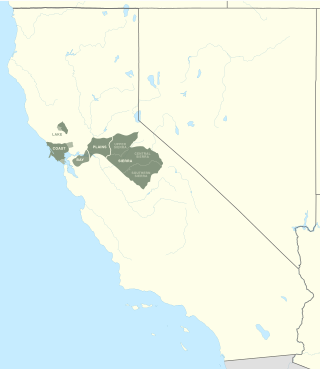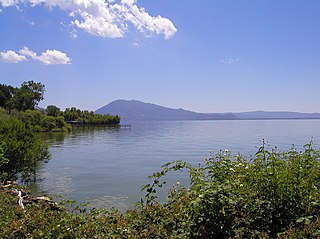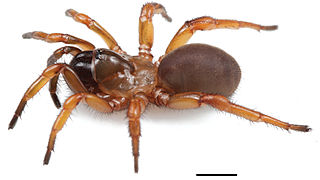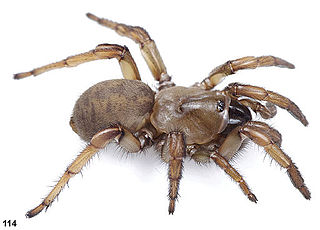
The Miwok are members of four linguistically related Native American groups indigenous to what is now Northern California, who traditionally spoke one of the Miwok languages in the Utian family. The word Miwok means people in the Miwok languages.

Coast Miwok are an indigenous people that was the second-largest group of Miwok people. Coast Miwok inhabited the general area of modern Marin County and southern Sonoma County in Northern California, from the Golden Gate north to Duncans Point and eastward to Sonoma Creek. Coast Miwok included the Bodega Bay Miwok, or Olamentko (Olamentke), from authenticated Miwok villages around Bodega Bay, the Marin Miwok, or Hookooeko (Huukuiko), and Southern Sonoma Miwok, or Lekahtewutko (Lekatuit). While they did not have an overarching name for themselves, the Coast Miwok word for people, Micha-ko, was suggested by A. L. Kroeber as a possible endonym, keeping with a common practice among tribal groups and the ethnographers studying them in the early 20th Century and with the term Miwok itself, which is the Central Sierra Miwok word for people.

Indian Grinding Rock State Historic Park is a California State Park, preserving an outcropping of marbleized limestone with some 1,185 mortar holes—the largest collection of bedrock mortars in North America. It is located in the Sierra Nevada foothills, 8 miles (13 km) east of Jackson. The park is nestled in a little valley 2,400 feet (732 m) above sea level, with open meadows and large specimens of valley oak that once provided the Miwok peoples of this area with an ample supply of acorns. The 135-acre (55 ha) park was established in 1962 and listed on the National Register of Historic Places in 1971.

The Lake Miwok are a branch of the Miwok, a Native American people of Northern California. The Lake Miwok lived in the Clear Lake basin of what is now called Lake County. While they did not have an overarching name for themselves, the Lake Miwok word for people, Hotsa-ho, was suggested by A. L. Kroeber as a possible endonym, keeping with a common practice among tribal groups and the ethnographers studying them in the early 20th Century and with the term Miwok itself, which is the Central Sierra Miwok word for people.

The Plains and Sierra Miwok were once the largest group of California Indian Miwok people, indigenous to California. Their homeland included regions of the Sacramento Valley, San Joaquin Valley, and the Sierra Nevada.

Myrmekiaphila is a genus of North American mygalomorph trapdoor spiders in the family Euctenizidae, and was first described by G. F. Atkinson in 1886. All described species are endemic to the southeastern United States.

Jason E. Bond is an American biologist working as a Professor of Entomology and the Schlinger Chair in Insect Systematics at the University of California, Davis.

Aptostichus stephencolberti is a species of spider in the family Euctenizidae, named after the American satirist Stephen Colbert. The spider was discovered on the California coastline in 2007.

Aptostichus is a genus of North American mygalomorph spiders in the family Euctenizidae, and was first described by Eugène Simon in 1891. They are found predominantly in southern California, United States.

Aptostichus angelinajolieae, the Angelina Jolie trapdoor spider, is a species of Euctenizidae, nocturnal arthropods who seize their prey after leaping out of their burrows and inject it with venom. It was described by the Auburn University professor Jason Bond in 2008, who named it after the American actress Angelina Jolie in recognition of her work on the United Nations High Commission for Refugees. It was one of only seven described species of Aptostichus until 2012, when it was joined by Bono's Joshua Tree trapdoor spider and 32 other species.

The Cosumnes River Preserve is a nature preserve of over 51,000 acres (210 km2) located 20 miles (30 km) south of Sacramento, in the US state of California. The preserve protects a Central Valley remnant that once contained one of the largest expanses of oak tree savanna, riparian oak forest and wetland habitat in North America. Agricultural development has changed the landscape from groves of oaks and tule marshes to productive farmlands.
The Lake Miwok language is an extinct language of Northern California, traditionally spoken in an area adjacent to the Clear Lake. It is one of the languages of the Clear Lake Linguistic Area, along with Patwin, East and Southeastern Pomo, and Wappo.

Aptostichus bonoi, or Bono's Joshua Tree trapdoor spider, is a morphological species of Euctenizidae spiders, nocturnal arthropods who seize their prey after leaping out of their burrows and inject it with venom. The species was found in Joshua Tree National Park, California, and described by the Auburn University professor Jason Bond in 2012. Only seven species of Aptostichus were known prior to 2012, including the Angelina Jolie trapdoor spider.

Aptostichus barackobamai, the Barack Obama trapdoor spider, is a species of spider in the family Euctenizidae named after the 44th President of the United States, Barack Obama. The species was first reported by Professor Jason Bond of Auburn University in December 2012 as one of 33 new species of the genus Aptostichus.
Apomastus schlingeri is a species of venomous spiders belonging to a family of trapdoor spiders. They produce a complex of neurotoxins called aptotoxins. Both known species of the genus are found in the United States.

The Euctenizidae are a family of mygalomorph spiders. They are now considered to be more closely related to Idiopidae.

Aptostichus simus is a species of trapdoor spider in the family Euctenizidae. It is a medium-sized mygalomorph found in the United States and Mexico.

Aptostichus stanfordianus, the Stanford Hills trapdoor spider, is a species of wafer-lid trapdoor spider (Euctenizidae) endemic to California in the United States.

Aptostichus atomarius, the San Bernardino hills trapdoor spider, is a species of wafer-lid trapdoor spider in the family Euctenizidae. It is found in the United States.

















